05. Jul 2022 - DOI 10.25626/0139
Gero Fedtke is a research associate at the Chair for the Comparison of European Dictatorships at Friedrich-Schiller-University, Jena. He studied Russian and East European History at Cologne University and obtained a PhD in History from Jena University. He has previously worked with the Buchenwald Memorial Foundation on the History of Forced Labour in Nazi-occupied Europe. His research focuses on Russian and Soviet Rule in Central Asia and Soviet literature on Nazi Concentration Camps.
Ivan Fukalov is a researcher at the regional headquarters of the French Institute for Central Asian Studies (IFEAC) in Bishkek, Kyrgystan, and an expert historian for the Konrad Adenauer Foundation in Central Asia. He received his PhD in History from the Kyrgyz National University in 2017 and taught at ADAM University of Bishkek. His main research concerns medieval history in Central Asia as well as the turning points in the history of the first half of the 20th century in the Central Asia countries.
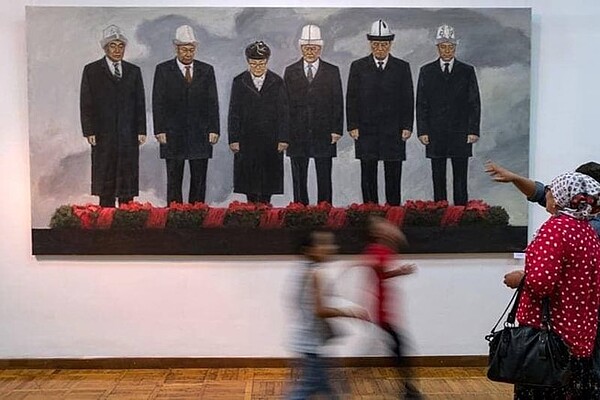
In August 2021, a painting entitled “Ata-Beyit”, on display at the exhibition “New Sotsrealism – 2” caused much ado in Kyrgyzstan’s social networks: the painting, by artist Taalay Usubaliyev, depicts all six of independent Kyrgyzstan’s presidents, each of them standing in a row, staring down at a mourning wreath at their feet. Behind them there is a grey sky with a cloud in the shape of Kyrgyzstan. Among the public’s reactions to this painting, Usubaliyev was accused of claiming that the presidents of independent Kyrgyzstan were attempting to “bury” Kyrgyzstan. Indeed, the Ata-Beyit Memorial Complex that this painting refers to in its title is a cemetery. The painter explained that his intention had been – quite the contrary – to call for “peace its and unity”:
Ata-Beyit is a sacred place for every citizen of Kyrgyzstan. I decided to depict this very place in order to remind them about our history, how our forefathers fought for the republic. […] All presidents are in one painting as a reminder that they are all responsible for our country and should unite for the sake of Kyrgyzstan’s future.[1]
Today’s Republic of Kyrgyzstan is a post-Soviet state, the borders of which were formed in 1924, when the Kyrgyz Soviet Socialist Republic (KSSR) became part of the Soviet Union. Before that, the territory had been a colony of the Russian Empire. In 1991, Kyrgyzstan became an independent state for the first time in its history. Various governments have since struggled to reconcile the conflicting aspects of this imperial history with a post-imperial historical narrative that would be able to unite contemporary Kyrgyz society in a Kyrgyz nation-state. Located some 30 kilometres south of Bishkek, Ata-Beyit is the main national memorial complex conveying such a historical narrative. Although the various memorials that constitute the complex are all about Kyrgyzstan’s past, taken together they convey a narrative of Kyrgyzstan’s history that projects into the future, just as in Usubaliyev’s statement.
Ata-Beyit tells the history of Kyrgyzstan as one of historical progress per aspera ad astra: through grievances, hardships and oppression to a better present and hopefully an even better future. The complex is also an assertion of Kyrgyzness, representing Kyrgyzstan as a nation of ethnic-Kyrgyz. Finally, the complex has a history of its own: Ata-Beyit was originally the site of a secret mass grave for 138 victims of Stalin’s Great Terror during the 1930s, which became an official burial and memorial site in 1991. Since then, several memorials have been added on site to form the memorial complex of today. Each new memorial has changed the way in which the already existing memorials could be (or should be) interpreted. In this article, we will scrutinize the development of the complex to show how its symbolic languages have changed over time. In short, with each monument that was added, the meaning of Ata-Beyit has changed. The development of the complex can thus be used as an indicator of Kyrgyzstan’s assertion of statehood since becoming independent.
Altogether there are four memorials at Ata-Beyit: the original burial site (1991) and memorial (2000), Chyngyz Aitmatov’s grave (2008) and memorial (2013), the burial site and memorial to the victims of Kyrgyzstan’s April revolution of 2010 (2011) and the Urkun memorial (2016).
On 5 and 8 November 1938, 137 men who had been sentenced to death by the Soviet Union’s High Court, were shot in Kyrgyzstan’s capital Frunze (now Bishkek) and then secretly buried at an NKVD-dacha near the village of Chon-Tash, south of the city. The mass grave was only discovered in 1991. The human remains were exhumed and the identities of the 137 men were established, although one female victim remains unidentified. All 138 victims were publicly commemorated with a mourning ceremony and were reburied nearby. In May 1992, the Ministry of Culture issued a public call for architectural proposals for a “Memorial Complex”, which ultimately came to nothing – allegedly due to a lack of funds. A year later, there was still nothing at the site, “neither a plate, nor an inscription, nor a sign. Only weeds the size of human beings.”[2] Relatives of the victims, however, visited the site regularly in order to privately commemorate. However, they had to share the site with tourists who liked to camp nearby, since the former NKVD dacha had become a popular tourist destination for sports and recreational outdoor activities. Eventually, after much protest by victims’ relatives, the site was closed to campers and marked with a simple slab of granite and a stela.
It was not only due to lack of funds that the site had been neglected by the state during the 1990s. The reburying ceremony of the victims had originally been planned for 23 August 1991 but it was postponed because of the failed coup attempt against Gorbachev in Moscow on 20 August; the ceremony was finally carried out on 30 August. The following day, Kyrgyzstan declared its independence. This chain of events may seem symbolic – commemorating victims of Soviet terror followed by denouncing the very Soviet state – but it actually just shows how unforeseeable and quickly such political events developed towards the end of the Soviet Union. The Kyrgyz government, as all other Central Asian governments, was taken by surprise when the leaders of Russia, Ukraine and Belarus decided to completely dissolve the Soviet Union in December 1991. Kyrgyzstan had to define its new statehood and create a national historical narrative, taking into account that no explicit Kyrgyz state had ever existed prior to the Soviet era. This obviously took time, and as the old Soviet ruling elite stayed in place after 1991, commemorating victims of Stalinist repression was clearly not a priority in the beginning. Although Kyrgyzstan’s victims of the Great Terror number in the thousands, and information about other mass graves was available, Chon-Tash did not establish a precedent and remained the only grave that was officially acknowledged. Moreover, the post-Soviet government dragged its feet when it came to assigning responsibility to a government authority to create and maintain the memorial. The responsible authority has changed several times since then.
As a consequence, it took almost nine years until the Memorial Complex to the Victims of Repressions “Ata-Beyit” was finally opened on 8 July 2000. The memorial complex is first and foremost a grave. It is spread out across a mountain slope leading upwards. Visitors climb stairs passing a sculpture of three suffering humans with distorted bodies and faces before they enter a square. In the centre of the square is the actual grave. Red granite plates carrying each individual victim’s name (apart from the unidentified woman) serve as gravestones. Visitors can move further up the hillside between two large-scale reliefs depicting men being led away by armed soldiers and mourned by wives and children. There is a viewing platform situated above the reliefs, the front side of which carries the inscription: “the truth can be bent, but not broken”. The path finally leads to the site of the former mass grave covered by a kumbez, a cupola symbolizing a mausoleum.
There is a museum exhibition that provides information about the victims and their and respective family histories. The 137 dead represent 19 nationalities, among them top- and middle-level functionaries of the KSSR such as Yusup Abdrakhmanov (Kyrgyz), head of the Soviet Kyrgyz government and Shakir Shafikov (Bashkir), head of a regional police office; there are also low-ranking party members among them such as Pavel L’vov (Russian), a bookkeeper and alleged Japanese spy. The youngest victim was 31, the oldest was 73. The exhibition also covers the Great Terror and its perpetrators, singling out Ivan Lotsmanov, then head of the Kyrgyz state security police (NKVD) who was responsible for the execution and burial of Chon-Tash’s victims and who was executed himself for treason and sabotage in 1940. The memorial neither conveys a narrative of Kyrgyzstan as a nation, nor is it dedicated to all victims of the Great Terror. In 2001, a veteran of the Second World War managed to have his father’s name engraved on one of the gravestones. The father was repressed and killed in 1938, but not buried at that place. The name was removed after this affair became known. Ata Beyit was a grave site, a place of mourning and remembrance only for those who were actually buried there. The site was mostly visited by the victims’ relatives and was very much neglected by the state.
The world-famous Kyrgyz author Chingiz Aitmatov, whose father had been among those 137 victims, played an important role in both the funding and the realization of the memorial. He authored the official name “Ata-Beyit” which simply means “fathers’ grave”. When Aitmatov died in 2008, he was buried on the site of the memorial next to the square. In the beginning, it was a simple grave without any signs, surrounded by a fence.[3] Later, a simple obelisk of black granite was installed and engraved with Aitmatov’s name and life dates. The memorial complex thus still remained a place for private commemoration and mourning.
The memorial complex’s shift from a site of private mourning and remembrance to a place of high significance for Kyrgyzstan’s public history and memory politics began in 2010. The first president of independent Kyrgyzstan, Askar Akayev, was removed from office in 2005 during the so-called ‘Tulip Revolution’ after allegations of election fraud. His successor, Kurmanbek Bakiyev, was also soon accused of cronyism and corruption as well as openly authoritarian tendencies that did nothing to solve Kyrgyzstan’s severe economic problems. He also proved unable to mediate the conflicts between the elite and various ethnic groups as well as between Kyrgyzstan’s poorer southern and richer northern regions. In Spring 2010, a drastic increase in energy tariffs sparked unrest and demonstrations were held in several cities. On the morning of 7 April 2010, thousands of partially armed demonstrators gathered in front of parliament and other government buildings in the capital of Bishkek. When demonstrators occupied parliament and attacked the government building, Bakiyev ordered snipers to fire into the crowd. This did not help his situation as the opposition seized power that same evening. Bakiyev moved to his home town of Osh in the south to mobilize local support, but he finally stopped resisting. On 15 April he fled Kyrgyzstan, resigned the following day from the presidency and eventually found exile in Lukashenko-controlled Belarus. According to official numbers, in Bishkek alone, 84 people died and more than 1500 were injured during the riots. The unrest and overthrow of the government was soon labelled the “April Revolution”. Unrest continued to shake Kyrgyzstan for a while longer, especially in the south, where intense clashes between ethnic Kyrgyz and Uzbek groups erupted over the summer.
As early as 10 April, in an official ceremony, 16 victims of the sniper shootings in Bishkek were buried in a field beneath the Ata-Beyit memorial; more than 20 000 people attended.[4]The press called those killed during the riots “patriots, who died for the freedom of the people of Kyrgyzstan.” On 16 November 2011, a memorial to the victims of the April Revolution was opened at Ata-Beyit. During the opening ceremony, prime minister Atambayev compared the victims to the 300 Spartans who gave their lives in the Battle of Thermopylae, saving Greece from the Persian invasion. He characterized the confrontation between the demonstrators and the forces of then-president Bakiyev as “a fight between good and evil, between the forces of light and the forces of darkness, between the people of Kyrgyzstan fighting for its freedom and a criminal regime.”[5] This rhetoric was in line with the image the opposition had already painted of Bakiyev before the events, denouncing him as a “khan” and a “monster”.[6] In 2013, the absent Bakiyev was sentenced to 24 years in a prison colony for abuse of power.
The April Revolution Memorial consists of a kumbez, a memorial wall engraved with the names of 95 victims, and 28 actual graves. The Historical-Memorial Museum ‘Taazim’ (obeisance) was later added. It contains an exhibition on the April Revolution and a room for mourning that displays the victims’ names and portraits. The addition of this new memorial changed the character of Ata-Beyit, which had now become a national memorial site thus losing its character as a grave site. Although there are actual graves and gravestones, the individuals are no longer central to the memorial. Next to the graves, there is a red granite wall with mounted black tiles that list 98 names of people not buried in Ata-Beyit but who were also killed in April 2010, honouring them as “heroes of the April people’s revolution”. This memorial represents the April Revolution as a decisive moment in recent Kyrgyz history that holds great significance for the future: it embodies the narrative of a nation overcoming an illegitimate authoritarian government and choosing the path of freedom and democracy. The ceremony on 10 April 2010 in which 16 victims were buried was already characterized as an ethnic-Kyrgyz event: in contrast to the typical use of two languages (Russian and Kyrgyz) at official events, only Kyrgyz was spoken, Islamic prayers were recited and the speakers addressed the participants as fellow Muslims or relatives (tuugandar).[7]
Such an ethno-national dimension is also expressed in the central construction of the 2010 memorial, which clearly aims to embed the memorial in an ethnic-Kyrgyz culture with both Islam and Nomadism as its central features. Three slightly bent portals in the shape of ayvans (a key element of Central Asian Islamic architecture) form a triangle that is crowned with a tunduk. A tunduk is the crown at the apex of a yurt, an important element in the culture of Central Asian peoples with a nomadic past (and present). It is the main element on the Kyrgyz national flag. In fact, a tunduk is present in each of the memorials in the complex. In the 1938 memorial, the tunduk is lying on the ground at the centre of the square surrounded by the gravestones. In the Kyrgyz tradition, a tunduk lying on the ground symbolizes grief and mourning the dead. Since there were not only Kyrgyz Muslims among the victims of 1938, a belltower was added to the memorial square in 2006, paying respect to the Christian – and also the Soviet atheist – tradition. In the symbolism of the 2010 memorial, the tunduk’s meaning shifts from grief and mourning towards its dimension as the Kyrgyz national symbol. This does not necessarily exclude the non-ethnic Kyrgyz victims, since Kyrgyzstan officially claims to be the multi-national state it actually is. The removal of the bell-tower in 2013, however, is a clear indicator of the narrative shifting towards exclusive ethnic Kyrgyzness and thus influences the reading of the tunduk as an ethnic Kyrgyz symbol. At the same time, the elevated position of the tunduk in the 2010 memorial indicates that it is not placed as a symbol of mourning, but of building a better national future.
In November 2013, Aitmatov’s grave (the obelisk) was replaced with a memorial the form of which follows the mutability of Ata-Beyit as a national memorial site. Aitmatov was not a victim of Soviet repression himself, but his literary work was devoted to stories of grief, of the weak, and of victimhood in various ways. At the same time, he was a national Kyrgyz hero, the one Kyrgyz author known to the whole world. Numerous statues, buildings, museums, and street names in his honour can be found in Kyrgyz cities. Since 2013, his grave is no longer simply the grave of a man buried next to his father, but a memorial dedicated to a great national figure.
The final memorial added was inaugurated on 2 September 2016: the Urkun memorial commemorates the victims of the 1916 “Central Asian revolt”.[8] This revolt took place in June 1916, when the tsarist government ordered the conscription of the indigenous inhabitants of its Central Asian and Caucasian territories as labourers for work behind the frontlines of the First World War. The conscription provoked an uprising against the Russian colonial power that was seen as corrupt and discriminating towards the indigenous populations, especially among the Kyrgyz and Kazakh populations. Tensions between local nomadic populations and Russian settlers that had been building up for decades now erupted in violence. The worst of the violence took place in what is now Kyrgyzstan’s north. The empire reacted with extreme brutality, bringing in troops from Central Russia, arming the peasant settlers and carrying out what we would call “ethnic cleansing” today. The punitive expeditions drove an estimated 250 000 Kyrgyz to flee to Xinjiang China across high mountain passes in the winter, thus suffering extreme mortality rates. The revolt left about 10 000 settlers and an estimated 100 000–200 000 indigenous Central Asians dead. Violence re-erupted the following year, when the refugees attempted to return, and continued into the turmoil of the civil war. “Urkun” – strictly meaning the “exodus” into China – is the Kyrgyz name for this tragedy. It left deep imprints in the collective historical consciousness and cultural memory of the Kyrgyz people – deeper even than the Stalinist terror of later decades, at least in the northern parts of the country.[9] In Soviet times, the revolt was first hailed as a prelude to the revolution, an anti-colonial uprising against tsarism. But this had to soon give way for an interpretation of the events as one of many national-liberation movements, as well as a class struggle that emphasized the union of Russian and Central Asian revolutionaries. Since the demise of the Soviet Union, Kyrgyz historiography mostly interprets the 1916 revolt as a stage in Kyrgyzstan’s national-liberation history, which in part continues the Soviet interpretation. The Urkun memorial is an architectural manifestation of this interpretation. Thus, the order (Ukaz) by president Atambayev for installing the monument calls the 1916 revolt a “fight for freedom.”
With the opening of the Urkun memorial, Ata-Beyit received the new name “National Historical Memorial Complex Ata-Beyit.” The Urkun memorial represents the biggest change and is decisive in shaping the symbolism of all the memorials in the complex. As the new name indicates, it turned Ata-Beyit from a memorial that commemorated actual victims of Soviet and post-Soviet oppression into a memorial that embodies the development of the Kyrgyz nation. The Urkun memorial replaces the 1938 memorial as the key memorial of the whole complex. It is not only the biggest of all memorials at Ata-Beyit, it is also physically above the museum dedicated to 1938 in such a way that the stairs that led to the original burial site now lead to the Urkun memorial, thus positioning it as the culmination of the entire complex.
As the authors of the complex explained, “the monument is located in a circle that symbolizes eternity” and consists of several parts. The central part is composed of three massive steles, faced with red granite, symbolizing uuki (concave wooden elements of the tent part of the yurt), crowned by a tunduk at the height of 21 meters. This central structure “was created on the basis of the Kyrgyz kumbez. We studied architectural monuments, and it turned out that the triangle is also a sacred symbol for the Kyrgyz. Therefore, triangles can be seen on the monument from different angles”, they noted.[10] Empty stirrups are directed upwards from the bottom towards the tunduk, symbolizing loss and tragedy, but not only that:
stirrups are a support, a support in order to rise up. Those who died in 1916 gave their lives and made sacrifices for the freedom of the people, their independence. This idea was realized with the formation of the Kyrgyz Republic in 1991. The stirrups directed towards the tunduk symbolize the path to independence.[11]
This architectural language fully corresponds to the words of president Atambayev at the opening on 2 September 2016 that, “the year 1916 provided an impulse for the national renaissance and creation of [our] own statehood. This process found its natural fulfilment in the attainment of state sovereignty in 1991.” Furthermore, the Ukaz by president Atambayev for installing the monument treats all victims buried and commemorated at Ata-Beyit as national heroes who gave their lives for Kyrgyz independence: “Those who died […] should be placed in one row with the other victims which the Kyrgyz people sacrificed for the sake of the renaissance of its statehood.”
As the sculptor of the memorial Saadanbek Ajiyev explained in an interview, his aim was to “show the historical course of these events.” This is accomplished by four monumental memorial bas-reliefs with a height of 3.5 meters and a total length of 39 meters. From left to right they unfold a peculiar narrative of the history of the Kyrgyz people during and after 1916, which Ajiyev explained are meant to represent the four phases: resistance – exodus – return – our new life (see pictures). The story depicted on the panels shows suffering ethnic Kyrgyz nomads fleeing an invisible enemy, climbing mountain passes, but then returning with healthy livestock and confidentially setting up their yurts again. In front of the memorial, lines from Mambetturdu Mametakun’s famous poem “We” (Biz, 1990) about the Kyrgyz people are presented:
We arrived on earth in white hats (kalpak), we descended from the heavens like rain. We were like grass which could not choose where to grow, we were scattered like a cloud blown across the world. We were about to vanish, but revived, we were about to split, but united.
Urkun is thus elevated as a metaphor for the historical fate of the Kyrgyz people. A decisive difference between the Urkun memorial and the other three memorials runs parallel to this notion: whereas these are fully or at least partially actual graves, remains of victims of 1916 are not buried at Ata-Beyit, neither did the region the memorial is situated in play any role in the events of 1916. An independent historical commission had suggested to bury the human remains of the victims of 1916 at the complex, but this idea did not materialize.
The story told by the bas-reliefs, however, necessarily reveals its omissions: a visitor not familiar with the narrative would find it difficult to understand the plot of the tragedy, because it is not shown why the people are suffering so much. Neither the cause nor the perpetrators of the uprising – tsarist soldiers and armed settlers – are shown. The independent historical commission in 2016 recognized Urkun as a genocide, but the Kyrgyz government decided for the established label “national uprising for liberation” – a term of Soviet historical tradition. It is said that this was decided so as to avoid giving Russia any reason for accusations, but this omission is at least as important as a feature of the reconciliation with Kyrgyzstan’s own Soviet past: the ‘new life’ depicted in panel four is full of easily recognizable key emblems of early Soviet modernity as propagated after the revolution. Panel four depicts a tractor ploughing a field, the Soviet symbol of the mechanization of agriculture. The yurt is illuminated by a light bulb hanging from the tunduk, the famous lampochka Il’icha (Lenin’s lamp) the symbol for the electrification. Three women holding books evoke the famous picture by Semyon Chuykov “Daughter of Soviet Kirgiziya” referring to the early Soviet alphabetization campaigns. But as much as the Russian Empire is not visible as the perpetrator of Urkun, the Soviet Empire is not visible as the source of the modernization and the ‘new life’. Furthermore, the story told in the bas-reliefs ignores the victims of Soviet forced modernization. The lampochka Il’icha was supposed to be installed not in a nomad yurt, but in a house, and the forced Soviet sedentarization campaign of 1928–1929 cost thousands of lives.
President Atambayev formulated this reconciliation with the Soviet and Russian past in his opening speech:
With the help of the Russian Soviet intelligentsia, the Kyrgyz managed to restore their culture, develop the economy and science. [...] The common people have always understood that the same common Russian people are not to blame for the tragedy of 1916. The people of Kyrgyzstan have never had nor have they now feelings of hatred towards the Russians or thirst for revenge. A vivid evidence of this is that just 25 years after the tragic events of 1916, starting in June 1941, hundreds of thousands of Kyrgyz went to fight shoulder to shoulder with the Russians on the fronts of the Great Patriotic War. [...] We have a common past with Russia and I am deeply convinced that we have a common future. We remember and appreciate all the good and bright things that connect our countries.
In terms of memorials, we find this attitude expressed in a conservation of most of the Soviet memorial landscape in Bishkek and other cities. The numerous memorials to the ‘Great Patriotic War’ are in place, and 9 May is still celebrated as ‘Victory Day’. In view of the Russian invasion of Ukraine, there has been no official parade this year, but the ‘immortal regiment’ was conducted in several cities with allegedly 15 000 participants, as reported by the media.
Since gaining its independence, Kyrgyzstan seeks to establish a historical narrative that reconciles Kyrgyzstan’s present with its Soviet and Russian past. This narrative tells a story of national liberation and achieving statehood of the ethnic Kyrgyz. At the same time, it attempts to integrate Kyrgyzstan’s multi-ethnic population and to recognize today’s political and economic significance of the former imperial power, the Russian Federation. This attempt consists of positively commemorating certain aspects of the Soviet era while forgetting others, among them the Stalinist terror. The aim of this narrative is to facilitate cohesion. It is necessarily subject to tension for the very reason that it has to integrate elements from different dimensions of memory.[12] Purposefully forgetting the violent side of Soviet modernization means compromising historical truth, but to serve the aim of reconciling the modern Kyrgyz state and society with its Soviet origins. This leads to a narrative which accentuates Soviet modernity as healing the wounds of Urkun without highlighting that Urkun was part of the Russian imperial past and that Soviet modernization rendered numerous victims itself; the victims of 1938 are all the while reinterpreted – from victims of (Soviet) Stalinism to heroes who fought for achieving Kyrgyz statehood. The narrative therefore does not have to be ‘historically truthful’ but it has to be veridical, i.e. acceptable to all relevant segments of Kyrgyzstan society. It is unsurprising then that the narrative continues Soviet traditions as well as the Soviet interpretation of 1916 and the years following in many respects. They are well-established in Kyrgyzstan to this day and thus stand the best chance of being accepted by the majority of Kyrgyzstan’s population.
At the same time, Kyrgyzstan’s historians have not yet been able to give a full and comprehensive postcolonial, post-socialist assessment of Kyrgyzstan’s recent history, including its causes and consequences. Postcolonial independence is a practice that requires the active development of techniques and skills of independent life, the formation of new institutions, processes and traditions. Moreover, independence requires former colonies of socialism to develop a detailed recalibration of relations with the inherited history, understood both as a discipline and as a story about the past. In post-socialist Kyrgyzstan, this resonates with the political importance of kinship ties. Kyrgyz researchers from both Kyrgyzstan and abroad have demonstrated how, since the collapse of the USSR, clans, understood as "collective identity networks", are the main means of mobilizing resources and circulating elites. Given the prominent place of Urkun in Kyrgyz social memories, the clan's proximity to the events of Urkun is still important for the Kyrgyz people. It is no coincidence that the current president S. Japarov indicates in his biography that his grandfather fled to China and thus was part of Urkun. The painter Usubaliyev makes use of this importance of Urkun in his call for a greater coherence of Kyrgyzstan’s political elite. Urkun had become sacred even before it was enclosed in a memorial to its victims in the village of Chon-Tash. Usubaliyev’s equating the sacrality of Urkun in Kyrgyz collective memory with the memorial complex indicates that the narrative presented at Ata-Beyit is acceptable.
Despite all justified criticism from a historian’s point of view, the narrative presented by the memorial has the potential to serve its purpose of providing cohesion for a post-Soviet, postcolonial state in times of trouble. Itself a source of collective memory, the memorial embodies three periods of the history of Kyrgyzstan at the same time, which is an exceptional cultural phenomenon in the post-Soviet sphere. The significance of the memorial also lies in the revival of memory, after both Urkun and the repressions of the Stalinist period had been hushed up or distorted for most of Kyrgyzstan’s Soviet period. It is important that the people who became the elites of the Kyrgyz society in the early Soviet decades had previously survived Urkun, only to then be destroyed by the Stalinist system. This connection should and could also be addressed in the memorial complex.
Research for this article was made possible by the generous support of the Federal Foundation for the Study of the Communist Dictatorship in East Germany.
Gero Fedtke and Ivan Fukalov: Creating ‘Kyrgyzness’: The Many Narratives of the Memorial Complex Ata-Beyit. Cultures of History Forum (04.07.2022), DOI: 10.25626/0139.
Copyright (c) 2022 by Imre Kertész Kolleg, all rights reserved. This work may be copied and redistributed for non-commercial, educational purposes, if permission is granted by the copyright holders. For permission please contact the editor.
See the video by the news agency Aki Press that gives an impression of the whole Ata-Beyit Memorial Complex and detailed pictures of the April revolution memorial
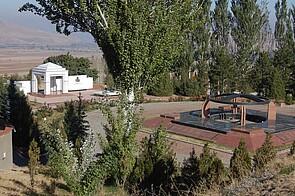
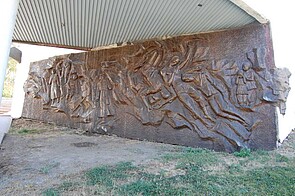
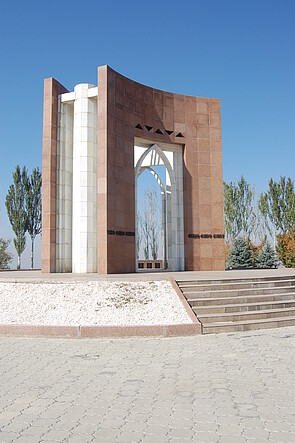
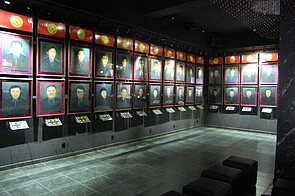
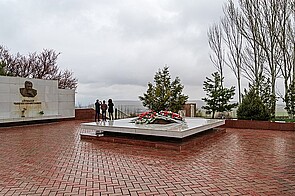
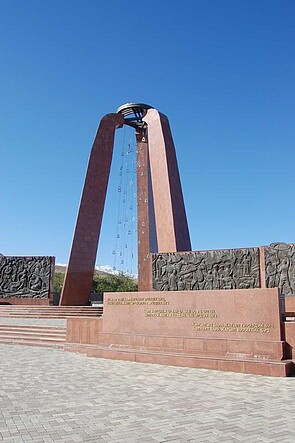

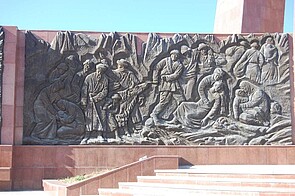
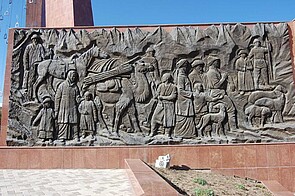
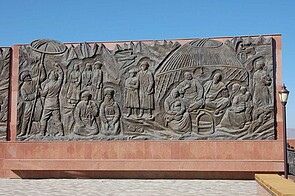
Get this article as PDF download (including pictures).